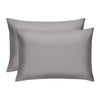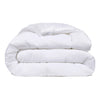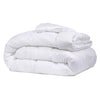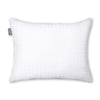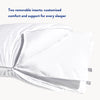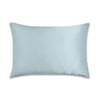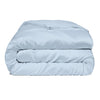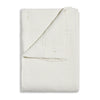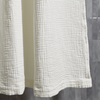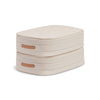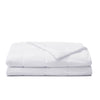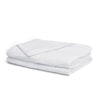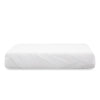The Daily Miracle
What Size Is a Standard Pillow?
Published
March 22, 2023
Author
Bridget Reed

There’s nothing worse than losing sleep over the best, most comfortable way to sleep. When choosing the right bedding, there are many different things to consider.
There’s nothing worse than losing sleep over the best, most comfortable way to sleep. When choosing the right bedding, there are many different things to consider.
From the type of sheets to the weight of your comforter to creating the optimal sleep environment to promote a good night’s rest — it’s a lot to stay on top of. And we haven’t even started talking about choosing the right pillow.
Among the many factors to consider is the size of your pillow — so what size is a standard pillow? So let’s talk about the primary option out there — a standard pillow — and the other different sizes of pillows you can choose from to help you decide which one is best for you.
So, what is the size of a standard pillow? And what other sizes are available?
What Are the Different Pillow Sizes?
Let’s answer the question on everyone’s mind right off the bat — what is a standard pillow size? A standard pillow is approximately 20” x 26”, or 51 cm x 66 cm. When we say “standard pillow,” it refers to the standard pillow size for a bed in the United States.
This is an important clarification because standard pillow sizes can vary from country to country. And they’re not to be confused with what might be referred to as the standard size for, say, a couch throw cushion.
So, what is a standard size pillow? Generally, this size is standard because it fits the width of a bed. One standard pillow will be nearly equal to the width of a twin bed, and two standard pillows side-by-side will make up the width of a full-sized bed. And what size is a standard pillow case? The case will be made to fit any standard pillow size.
There are other pillow sizes too, and they’re useful to know so that you can be sure you’re selecting the right pillows for your bed and buying the right pillowcases for your pillows.
In addition to standard, there are what’s called super standardpillows. They’re two inches longer than the standard size (so 20” x 28” or 51 cm x 71cm.) They’re great for larger beds or if you’d prefer to use one pillow on a twin or full mattress instead of two.
Queen and king-sized pillows are exactly what you’ve probably assumed they are: pillows that are best suited to those respective mattress sizes. Queen size pillows are 20” x 30” or 51 cm x 76 cm, and king pillows have extra length and are 20” x 36” or 51 cm x 92 cm.
This is obvious, but it’s important to note that as we’re going up in pillow size so far, we’re only lengthening them horizontally — they stay the same height no matter what.
This holds true up to body pillows, which run an impressive and uber-snuggly 20” x 54” or 51 cm x 137 cm. They fit across queen or king-sized beds and are usually used in conjunction with other pillows as an accent or sleep aid instead of an alternative to smaller pillows.
Why Do Pillows Come in Different Sizes?
We’ve touched on the first, simplest answer to this question: pillows come in different sizes to correspond to different bed sizes. While a standard size pillow is perfect for a twin or full-sized bed, they look a bit funny on queen, king, and especially super king beds. They’re just not big enough to cover the space.
This is also why pillow sizes vary between countries. If you’re considering a move to another country or are currently planning it and want to take your most beloved sheet sets with you, it’s worth looking into the standard sizes of beds and pillows in your destination country.
You may need to import pillows and a mattress if you want to keep your sheets — at which point, it probably makes more sense just to swap out your sheets for something local.
Pillows come in different sizes for a couple of other reasons, too: personal preference and to give you a variety of options! While technically, a king-sized pillow may be too big for your full-sized bed, if you feel most comfortable with an oversized pillow or simply prefer the look of it, there’s no reason why you can’t mix and match.
The different sizes of pillows give you more options when it comes to both style and comfort. Additionally, knowing the standard pillow size (as well as the standard sizes for other pillows) can help you to choose the pillow that best suits your needs. But other factors go into that, too.
How Do You Choose a Pillow?
In addition to size, there are other factors to consider. Pillows are a super important part of creating the optimal environment for a good night’s sleep. It’s easy to forget just how crucial they are. They support your neck and head, alleviating problems ranging from allergy symptoms and post-nasal drip to snoring and neck pain.
You’ll want to consider what size of pillows are best suited for your bed. But you’ll also want to think about your preferred sleep position to choose the best shape and firmness, as well as the number of pillows you should have on your bed.
If you sleep on your side, firmer pillows with more filling will improve your sleep quality by better supporting your neck. If you sleep on your back, a thinner, softer pillow will offer more cushioning for your head and neck without lifting you into an uncomfortable position. Stomach sleepers should look for the thinnest, softest pillows of all, designed to avoid straining your neck.
What About Pillowcases?
Pillowcases are non-negotiable when it comes to pillows on your bed. You’ll spend so much time sleeping on them, and while you can wash pillows, they take a while to dry and will wear out more quickly with frequent washes, so they need protection.
It’s crucial to wash your pillowcases even more regularly than the rest of your sheets because they’re in direct contact with your face. Dirty pillowcases can cause breakouts, rashes, and even exacerbate allergies.
That’s why we prefer to use our Miracle Made Pillowcases. Our pillowcases are infused with silver, providing many benefits to you, including preventing up to 99.7 percent of bacteria growth.
This means less washing, fewer odors, and a reduction in breakouts and morning stuffiness. They come in a wide range of colors (to match the rest of our bedding products) and both standard and king sizes, too.
Takeaway
Whether you’re totally revamping your bedding setup or just aren’t happy with the comfort level of your pillows, understanding the different sizes of pillows available can help you make informed decisions more easily.
While almost all bedding sets will come with standard pillowcases, there are many other sizes of pillows to choose from, and if the ones you have aren’t cutting it, it’s a good idea to explore your options!
Of course, there’s more to choosing your bedding than the size of your pillow. You also have to consider the materials that make it up, its firmness, and how easy it will be to care for.
But armed with more info about what’s out there, you’ll be able to find the perfect pillow for even the pickiest sleeper, making your journey into dreamland all the smoother.
Sources:
Pillow Sizes | Sleep Foundation
Good Sleep Environment | Centers for Disease Control and Prevention
Dust Mites and Cockroaches | National Institute of Environmental Health Sciences


